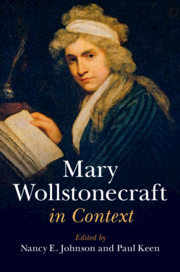Book contents
- Mary Wollstonecraft in Context
- Mary Wollstonecraft in Context
- Copyright page
- Contents
- Illustrations
- Notes on Contributors
- Preface
- Frontispiece
- Chronology
- Part I Life and Works
- Part II Critical Fortunes
- Part III Historical and Cultural Contexts
- The French Revolution Debate
- The Rights of Woman Debate
- Philosophical Frameworks
- Legal and Social Culture
- Chapter 23 The Constitution
- Chapter 24 Property Law
- Chapter 25 Domestic Law
- Chapter 26 Slavery and Abolition
- Chapter 27 The Bluestockings
- Chapter 28 Conduct Literature
- Chapter 29 Theories of Education
- Literature
- Suggested Further Reading
- Index
Chapter 29 - Theories of Education
from Legal and Social Culture
Published online by Cambridge University Press: 16 January 2020
- Mary Wollstonecraft in Context
- Mary Wollstonecraft in Context
- Copyright page
- Contents
- Illustrations
- Notes on Contributors
- Preface
- Frontispiece
- Chronology
- Part I Life and Works
- Part II Critical Fortunes
- Part III Historical and Cultural Contexts
- The French Revolution Debate
- The Rights of Woman Debate
- Philosophical Frameworks
- Legal and Social Culture
- Chapter 23 The Constitution
- Chapter 24 Property Law
- Chapter 25 Domestic Law
- Chapter 26 Slavery and Abolition
- Chapter 27 The Bluestockings
- Chapter 28 Conduct Literature
- Chapter 29 Theories of Education
- Literature
- Suggested Further Reading
- Index
Summary
Mary Wollstonecraft came to write about education in much the same way that John Locke and Immanuel Kant did: she wrote after having taught. Running a school with her sisters Everina and Eliza for a time and working as a governess to the daughters of the Kingsborough family in Ireland prompted her to set down her ideas about the work that a teacher should perform and the difficulties that the teacher might face.1 While Locke and Kant recommended that parents choose their children’s tutors carefully and pay them well, Wollstonecraft’s experiences led her to outline her pedagogical ideas in Thoughts on the Education of Daughters (1787) and to produce instructive fictions in Original Stories from Real Life (1788).2 She took a broad view of education, and imagined that it did not merely concern the teaching of particular subjects such as spelling or math. In her extensive survey, education offered an opportunity to develop moral and political skills for daily living, even in the confines of a household. As Wollstonecraft observed in A Vindication of the Rights of Woman, education was essential if women were to be able to be good mothers and wives, and not to tyrannize children and servants out of a sense that they were themselves tyrannized.3
- Type
- Chapter
- Information
- Mary Wollstonecraft in Context , pp. 246 - 254Publisher: Cambridge University PressPrint publication year: 2020



